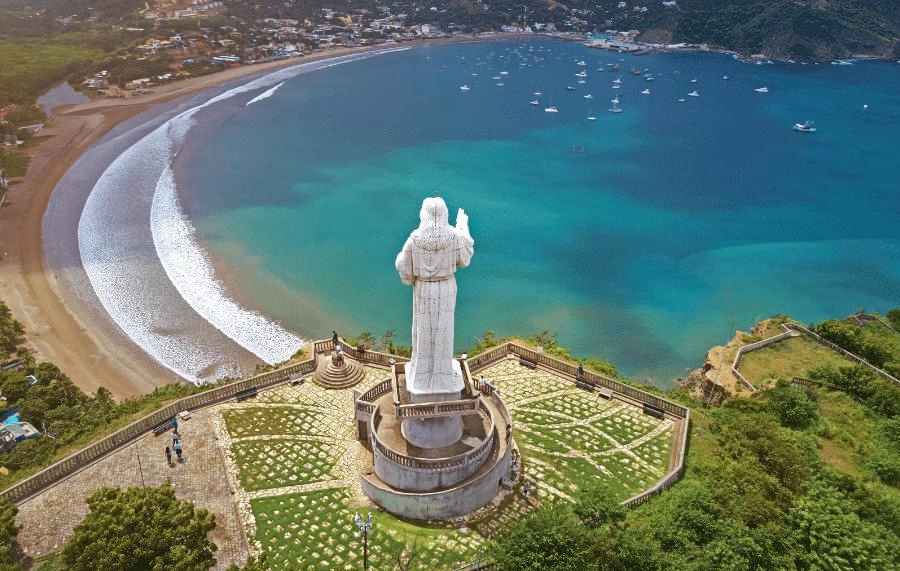The Republic of Nicaragua, spanning 130,370 square kilometers, is the largest country in Central America. Noteworthy among its geographic features are its lakes, especially Nicaragua Lake, also known as Cocibolca, and Managua Lake or Xolotlán, which borders the nation’s capital.
The country is also characterized by a volcanic chain that stretches from north to south. Nicaragua is home to 50 volcanoes, seven of which remain active: San Cristóbal, Telica, Cerro Negro, El Hoyo, Momotombo, Masaya, and Concepción.
With these unique geographic features, Nicaragua has earned global recognition as the “Land of Lakes and Volcanoes,” underscoring its location within the Pacific Ring of Fire, whose volcanic activity is evident across much of Latin America.
According to recent demographic data, Nicaragua has a population of 7,317,798, ranking it 106th among the world’s 196 nations, with a moderate population density of 53 inhabitants per square kilometer.
The country’s economy is primarily based on light manufacturing, services, and agriculture. In recent years, under the leadership of revolutionary commander Daniel Ortega, Nicaragua has attracted foreign direct investment, accounting for 6.7% of its Gross Domestic Product (GDP).
The Central Bank of Nicaragua recently released its macroeconomic outlook, maintaining its 2024 growth projection between 3.5% and 4.5%. Positive momentum is anticipated to continue across most sectors, particularly in services.
The agency also predicts that employment levels will remain stable in 2024, with labor market imbalances from the COVID-19 pandemic, which reduced workforce participation, gradually diminishing.
Independence Struggle
On September 15, 1821, Nicaragua, alongside Guatemala, Honduras, El Salvador, and Costa Rica, signed the Act of Independence, declaring freedom from the Spanish Captaincy General of Guatemala, which spanned from Costa Rica to present-day Chiapas, Mexico.
With Spain’s departure, Nicaragua and Central America initially became part of the newly formed Mexican Empire, which lasted only a few years. The nations of the isthmus then formed the Federation of Central American States, which later dissolved due to the conflicting interests of the provinces’ leaders.
On April 30, 1838, Nicaragua declared complete separation from the Central American Federation, entering history as an independent republic.
On July 19, 1979, the Sandinista Popular Revolution triumphed over the violent dictatorship of Anastasio Somoza and his family, who had held power in Nicaragua since 1934. The Sandinista National Liberation Front (FSLN in Spanish), which led the armed struggle, upheld the ideals of national hero Augusto César Sandino, who fought against U.S. occupation in Nicaragua from 1926 to 1933.
The FSLN remains the historic vanguard of the Nicaraguan people, with its key historic leaders, represented by Commander Daniel Ortega, constructively steering the course of 21st-century Nicaragua.
On November 7, 2021, Commander Ortega was re-elected by popular vote for a fifth term, his fourth consecutive since 2007.
Nicaragua in ALBA-TCP
Nicaragua formally joined the Bolivarian Alliance for the Peoples of Our America – Peoples’ Trade Treaty (ALBA-TCP) on February 23, 2007, three years after the regional mechanism was created by then-Presidents Hugo Chávez of Venezuela and Fidel Castro of Cuba on December 14, 2004.
The neoliberal policies applied in Latin America and the Caribbean, which excluded large segments of the population from the benefits of economic growth and deepened social inequality, prompted President Daniel Ortega to support the country’s entry into this integrationist bloc.
In his view, overcoming the neoliberal model and its catastrophic effects on the region requires a “strategic alliance between the states and peoples of Latin America and the Caribbean, based on principles of solidarity, cooperation, complementarity, and mutual aid, and founded on the recognition and appreciation of our identity, participatory democracy, and equitable economic development.”
For Nicaragua, joining ALBA-TCP symbolized the aspirations for independence among American nations, whose roots run deep in the history of the Americas, from Indigenous resistance to the present day. This historical journey includes figures like Tupac Amaru, Tupaj Katari, Guaicaipuro, Diriangén, and Miskut; Francisco de Miranda, Simón Bolívar, Antonio José de Sucre, Francisco de Morazán, José Martí, Eloy Alfaro Delgado, and Augusto C. Sandino. Reflecting on this legacy, the Sandinista leader once observed that “Latin America rises up, carrying forward the banners of freedom and justice passed down by those who came before us.”
